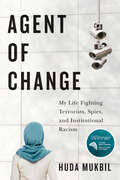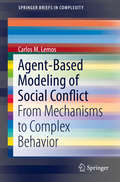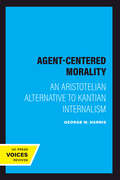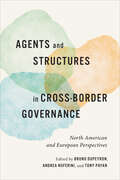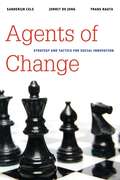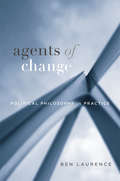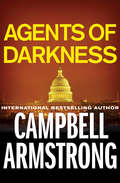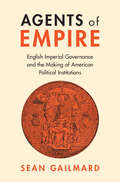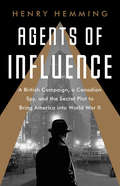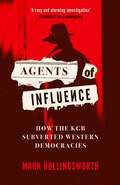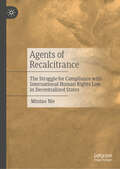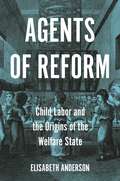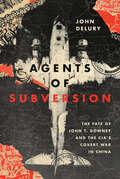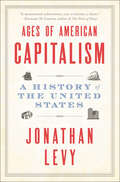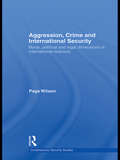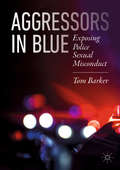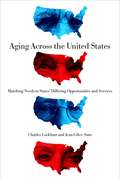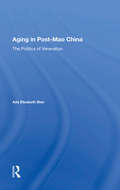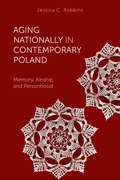- Table View
- List View
Agent of Change: My Life Fighting Terrorists, Spies, and Institutional Racism
by Huda MukbilIn Agent of Change Huda Mukbil takes us behind the curtain of a leading spy agency during a fraught time, recounting her experiences as an intelligence officer for the Canadian Security Intelligence Service. Mukbil was the first Black Arab-Canadian Muslim woman to join CSIS and was at the forefront of the fight against terrorism after 9/11.Mukbil’s mastery of four languages quickly made her a counterterrorism expert and a uniquely valuable asset to the organization. But as she worked with colleagues to confront new international threats, she also struggled for acceptance and recognition at the agency. Following the American-led invasion of Iraq in 2003 and the rise of homegrown extremism, Mukbil was framed as an inside threat. Determined to prove her loyalty, while equally concerned about the surveillance and profiling of Muslims and revelations of Western agencies’ torture and torture by proxy, Mukbil started to question CSIS’s fluctuating ethical stance in relation to its mandate. Her stellar work on a secondment to MI5, the British Security Service, earned commendation; this shielded her, but only temporarily, from the hostile workplace culture at CSIS. Ultimately, Mukbil and a group of colleagues went public about the pervasive institutional discrimination undermining CSIS and national security from within.Mukbil’s expertise in international security and her commitment to workplace transparency drove important changes at CSIS. Dazzlingly written, her account is an eye-opener for anyone wanting to understand how racism, misogyny, and Islamophobia undermine not only individuals, but institutions and the national interest – and how addressing this openly can tackle populism and misinformation.
Agent-Based Modeling of Social Conflict: From Mechanisms to Complex Behavior (SpringerBriefs in Complexity)
by Carlos M. LemosThis Brief revisits and extends Epstein's classical agent-based model of civil violence by considering important mechanisms suggested by social conflict theories. Among them are: relative deprivation as generator of hardship, generalized vanishing of the risk perception ('massive fear loss') when the uprisings surpass a certain threshold, endogenous legitimacy feedback, and network influence effects represented by the mechanism of dispositional contagion. The model is explored in a set of computer experiments designed to provide insight on how mechanisms lead to increased complexity of the solutions. The results of the simulations are compared with statistical analyses of estimated size, duration and recurrence of large demonstrations and riots for eight African countries affected by the "Arab Spring," based on the Social Conflict Analysis Database. It is shown that the extensions to Epstein's model proposed herein lead to increased "generative capacity" of the agent-based model (i. e. a richer set of meaningful qualitative behaviors) as well the identification of key mechanisms and associated parameters with tipping points. The use of quantitative information (international indicators and statistical analyses of conflict events) allows the assessment of the plausibility of input parameter values and simulated results, and thus a better understanding of the model's strengths and limitations. The contributions of the present work for understanding how mechanisms of large scale conflict lead to complex behavior include a new form of the estimated arrest probability, a simple representation of political vs economic deprivation with a parameter which controls the `sensitivity' to value, endogenous legitimacy feedback, and the effect of network influences (due to small groups and "activists"). In addition, the analysis of the Social Conflict Analysis Database provided a quantitative description of the impact of the "Arab Spring" in several countries focused on complexity issues such as peaceful vs violent, spontaneous vs organized, and patterns of size, duration and recurrence of conflict events in this recent and important large-scale conflict process. This book will appeal to students and researchers working in these computational social science subfields.
Agent-Centered Morality: An Aristotelian Alternative to Kantian Internalism
by George W. HarrisWhat kinds of persons do we aspire to be, and how do our aspirations fit with our ideas of rationality? In Agent-Centered Morality, George Harris argues that most of us aspire to a certain sort of integrity: We wish to be respectful of and sympathetic to others, and to be loving parents, friends, and members of our communities. Against a prevailing Kantian consensus, Harris offers an Aristotelian view of the problems presented by practical reason, problems of integrating all our concerns into a coherent, meaningful life in a way that preserves our integrity. The task of solving these problems is "the integration test." Systematically addressing the work of major Kantian thinkers, Harris shows that even the most advanced contemporary versions of the Kantian view fail to integrate all of the values that correspond to what we call a moral life. By demonstrating how the meaning of life and practical reason are internally related, he constructs from Aristotle's thought a conceptual scheme that successfully integrates all the characteristics that make a life meaningful, without jeopardizing the place of any. Harris's elucidation of this approach is a major contribution to debates on human agency, practical reason, and morality.
Agente: Female Secret Agents in World Wars, Cold War and Civil Wars
by Douglas BoydForget the adventure stories of James Bond, Kim Philby, Klaus Fuchs and co. – espionage is not just a boys’ game. As long as there has been conflict, there have been female agents behind the scenes. In Belgium and northern France in 1914–18 there were several thousand women actively working against the Kaiser’s forces occupying their homelands. In the Second World War, women of many nations opposed the Nazis, risking the firing squad or decapitation by axe or guillotine. Yet, many of those women did not have the right to vote for a government or even open a bank account. So why did they do it?Female Secret Agents explores the lives and the motivations of the women of many races and social classes who have risked their lives as secret agents, and celebrates their intelligence, strength and courage.
Agents and Structures in Cross-Border Governance: North American and European Perspectives
by Tony Payan Bruno Dupeyron Andrea NoferiniIn North America and Europe, cross-border governance arrangements have provided formal and informal frameworks to support cross-border cooperation. Analysing how these frameworks have emerged, the ways in which they have become institutionalized, and the processes by which they change is fundamental. Moreover, these frameworks are increasingly challenged by border securitization, thus limiting or jeopardizing decades of cross-border cooperative governance and coordinated public policies. Agents and Structures in Cross-Border Governance offers a series of case studies that explore these complex dynamics. To understand a range of cross-border governance frameworks, this collection addresses such topics as infrastructure development and management, resource sharing, regional politics, economics, security, human rights, the environment, culture, and community. The book explains how cross-border governance schemes have sought to mitigate some of the negative consequences of border security policies, allowing readers to discern how concrete national power struggles between federal/national and subnational governments unfold in border areas. In a world increasingly impacted by climate change and more recently the COVID-19 pandemic, Agents and Structures in Cross-Border Governance sheds light on the ongoing complexity of cross-border governance and offers lessons to help mitigate these challenges.
Agents of Bioterrorism: Pathogens and Their Weaponization
by Geoffrey ZubayThis new work offers a clear and thorough account of the threats posed by bioterrorism from the perspective of biologists. The authors examine thirteen disease-causing agents, including those responsible for anthrax, the plague, smallpox, influenza, and SARS. Each chapter considers a particular pathogen from the standpoint of its history, molecular biology, pathology, clinical presentation, diagnosis, weaponization, and defenses. The book also examines strategies for making vaccines and protecting the population in a bioterror attack.
Agents of Change
by Frans Nauta Sanderijn Cels Jorrit De JongWhile governments around the world struggle to maintain service levels amid fiscal crises, social innovators are improving social outcomes for citizens by changing the system from within. In Agents of Change, three cutting-edge thinkers and entrepreneurs present case studies of social innovation that have led to significant social change. Drawing on original empirical research in the United States, Canada, Japan, Germany, Denmark, and the Netherlands, they examine how ordinary people accomplished extraordinary results.Sanderijn Cels, Jorrit de Jong, and Frans Nauta offer lively illustrations and insightful interpretations of how innovators, social entrepreneurs, and change agents are dealing with powerful opponents, the burdens of bureaucracy, and the challenge of securing resources and support. This book will appeal to anyone who is intrigued by imaginative, cross-boundary thinking and transformative change. It will be of particular interest to those who want to know how exactly innovators pull it off. With practitioners, scholars, and students of public policy and management in mind, the authors dissect the strategies and tactics that social innovators employ to navigate the risky waters of their institutional environments.Contents Part 1: Introduction: Chess Masters and Acrobats 1. Strategy and Tactics2. Crafting the Case: The Art of Making a Start3. Prompting Progress: The Art of Making Things Happen4. Managing Meaning: The Art of Making SensePart 2: Front-Line Innovations 5. Under the Radar: Medical Informatics in Japan6. Relentless Incrementalism: Financial Literacy Training for Newcomers in Canada7. Join the Club! Alzheimer Cafés in the Netherlands8. Just a Tool? Implementing the Vulnerability Index in New OrleansPart 3: Innovations in Governance 9. The Sun Kings: Solar Energy in Germany10. Change on Steroids: Public Education in New Orleans11. The Value of Values: Higher Education in Virginia12. A Window of Opportunity: Institutional Reform in DenmarkConclusion: Innovating Strategically
Agents of Change: Political Philosophy in Practice
by Ben LaurenceAn incisive argument for the relevance of political philosophy and its possibility of effecting change. The appeal of political philosophy is that it will answer questions about justice for the sake of political action. But contemporary political philosophy struggles to live up to this promise. Since the death of John Rawls, political philosophers have become absorbed in methodological debates, leading to an impasse between two unattractive tendencies: utopians argue that philosophy should focus uncompromisingly on abstract questions of justice, while pragmatists argue that we should concern ourselves only with local efforts to ameliorate injustice. Agents of Change shows a way forward. Ben Laurence argues that we can combine utopian justice and the pragmatic response to injustice in a political philosophy that unifies theory and practice in pursuit of change. Political philosophy, on this view, is not a purely normative theory disconnected from practice. Rather, political philosophy is itself a practice—an exercise of practical reason issuing in action. Laurence contends that this exercise begins in ordinary life with the confrontation with injustice. Philosophy draws ideas about justice from this encounter to be pursued through political action. Laurence shows that the task of political philosophy is not complete until it asks the question “What is to be done?” and deliberates actionable answers.
Agents of Change: Strategy and Tactics for Social Innovation
by Frans Nauta Sanderijn Cels Jorrit De JongWhile governments around the world struggle to maintain service levels amid fiscal crises, social innovators are improving social outcomes for citizens by changing the system from within. In Agents of Change, three cutting-edge thinkers and entrepreneurs present case studies of social innovation that have led to significant social change. Drawing on original empirical research in the United States, Canada, Japan, Germany, Denmark, and the Netherlands, they examine how ordinary people accomplished extraordinary results.Sanderijn Cels, Jorrit de Jong, and Frans Nauta offer lively illustrations and insightful interpretations of how innovators, social entrepreneurs, and change agents are dealing with powerful opponents, the burdens of bureaucracy, and the challenge of securing resources and support. This book will appeal to anyone who is intrigued by imaginative, cross-boundary thinking and transformative change. It will be of particular interest to those who want to know how exactly innovators pull it off. With practitioners, scholars, and students of public policy and management in mind, the authors dissect the strategies and tactics that social innovators employ to navigate the risky waters of their institutional environments.Contents Part 1: Introduction: Chess Masters and Acrobats 1. Strategy and Tactics2. Crafting the Case: The Art of Making a Start3. Prompting Progress: The Art of Making Things Happen4. Managing Meaning: The Art of Making SensePart 2: Front-Line Innovations 5. Under the Radar: Medical Informatics in Japan6. Relentless Incrementalism: Financial Literacy Training for Newcomers in Canada7. Join the Club! Alzheimer Caf?s in the Netherlands8. Just a Tool? Implementing the Vulnerability Index in New OrleansPart 3: Innovations in Governance 9. The Sun Kings: Solar Energy in Germany10. Change on Steroids: Public Education in New Orleans11. The Value of Values: Higher Education in Virginia12. A Window of Opportunity: Institutional Reform in DenmarkConclusion: Innovating Strategically
Agents of Darkness
by Campbell ArmstrongIn international bestselling author Campbell Armstrong's thrilling, sophisticated tale of espionage, an assassin's vengeance triggers the exposure of a lethal conspiracy at the heart of the US government The director of the CIA lies unconscious and close to death in a private clinic, and his likely successor waits on his Pennsylvania estate while the power brokers in Washington, DC, do their deals. In the meantime, a man in Dallas is murdered. And on the other side of the globe, in Manila, a nondescript American is killed in his lover's back-alley apartment. Hard-drinking Scotsman Charlie Galloway, who has been suspended from his job in the LAPD, unofficially looks into the murder of a Filipino woman. Step by step, his investigation leads him to the nation's capital, where a shocking conspiracy reaches deep into the heart of government. [Reviews]
Agents of Empire: English Imperial Governance and the Making of American Political Institutions
by Sean GailmardTo understand the foundations of American political institutions, it's necessary to understand the rationale for British colonial institutions that survived the empire. Political institutions in England's American colonies were neither direct imports from England, nor home-grown creations of autonomous colonists. Instead, they emerged from efforts of the English Crown to assert control over their colonies amid limited English state and military capacity. Agents of Empire explores the strategic dilemmas facing a constrained crown in its attempts to assert control. The study argues that colonial institutions emerged from the crown's management of authority delegated to agents-first companies and proprietors establishing colonies; then imperial officials governing the polities they created. The institutions remaining from these strategic dynamics form the building blocks of federalism, legislative power, separation of powers, judicial review, and other institutions that comprise the American polity today.
Agents of Influence: A British Campaign, a Canadian Spy, and the Secret Plot to Bring America into World War II
by Henry HemmingThe astonishing story of the British spies who set out to draw America into World War IIAs World War II raged into its second year, Britain sought a powerful ally to join its cause-but the American public was sharply divided on the subject. Canadian-born MI6 officer William Stephenson, with his knowledge and influence in North America, was chosen to change their minds by any means necessary.In this extraordinary tale of foreign influence on American shores, Henry Hemming shows how Stephenson came to New York--hiring Canadian staffers to keep his operations secret--and flooded the American market with propaganda supporting Franklin Roosevelt and decrying Nazism. His chief opponent was Charles Lindbergh, an insurgent populist who campaigned under the slogan "America First" and had no interest in the war. This set up a shadow duel between Lindbergh and Stephenson, each trying to turn public opinion his way, with the lives of millions potentially on the line.
Agents of Influence: How the KGB Subverted Western Democracies
by Mark HollingsworthThere&’s no such thing as a former KGB man. Agents of Influence reveals the secret history of an intelligence agency gone out of control, accountable to no one but itself and intent on subverting Western politics on a near-inconceivable scale. In 1985, 1,300 KGB officers were stationed in the USA. The FBI only had 350 counter-intelligence officers. Since the early days of the Cold War, the KGB seduced parliamentarians and diplomats, infiltrated the highest echelons of the Civil Service, and planted fake news in papers across the world. More disturbingly, it never stopped. Putin is a KGB man through and through. Journalist Mark Hollingworth reveals how disinformation, kompromat and secret surveillance continue to play key roles in Russia&’s war with Ukraine. It seems frighteningly easy to destabilise Western democracy.
Agents of Neoliberal Globalization
by Michael C. Dreiling Darves Derek Y.Depictions of globalization commonly recite a story of a market unleashed, bringing Big Macs and iPhones to all corners of the world. Human society appears as a passive observer to a busy revolution of an invisible global market, paradoxically unfolding by its own energy. Sometimes, this market is thought to be unleashed by politicians working on the surface of an autonomous state. This book rejects both perspectives and provides an analytically rich alternative to conventional approaches to globalization. By the 1980s, an enduring corporate coalition advanced in nearly synonymous terms free trade, tax cuts, and deregulation. Highly networked corporate leaders and state officials worked in concert to produce the trade policy framework for neoliberal globalization. Marshalling original network data and a historical narrative, this book shows that the globalizing corporate titans of the late 1960s aligned with economic conservatives to set into motion this vision of a global free market.
Agents of Recalcitrance: The Struggle for Compliance with International Human Rights Law in Decentralized States
by Mintao NieFulfilling human rights treaty obligations extends beyond the mere ratification by national governments; it depends on the practices of local authorities, which continuously remake human rights standards and policies originating from higher levels of governance. In Agents of Recalcitrance: The Struggle for Compliance with International Human Rights Law in Decentralized States, Mintao Nie posits that governmental decentralization, characterized by increased autonomy for local authorities in local affairs, reduces state compliance with human rights treaties. This reduction occurs because governmental decentralization impedes the downward spread of human rights norms across governmental tiers, creates numerous local actors immune to moral pressure from the international society, and enables the central government to evade international censure by shifting blame for human rights abuses to local officials. This focus on central-local governmental relations challenges the assumption of states as unitary actors, offering a systematic understanding of how the varied motives and constraints across different levels of government affect the translation of international human rights law into local practice, in a volume that will interest scholars, activists and lawyers.
Agents of Reform: Child Labor and the Origins of the Welfare State (Princeton Studies in Global and Comparative Sociology)
by Elisabeth AndersonA groundbreaking account of how the welfare state began with early nineteenth-century child labor laws, and how middle-class and elite reformers made it happenThe beginnings of the modern welfare state are often traced to the late nineteenth-century labor movement and to policymakers’ efforts to appeal to working-class voters. But in Agents of Reform, Elisabeth Anderson shows that the regulatory welfare state began a half century earlier, in the 1830s, with the passage of the first child labor laws.Agents of Reform tells the story of how middle-class and elite reformers in Europe and the United States defined child labor as a threat to social order, and took the lead in bringing regulatory welfare into being. They built alliances to maneuver around powerful political blocks and instituted pathbreaking new employment protections. Later in the century, now with the help of organized labor, they created factory inspectorates to strengthen and routinize the state’s capacity to intervene in industrial working conditions.Agents of Reform compares seven in-depth case studies of key policy episodes in Germany, France, Belgium, Massachusetts, and Illinois. Foregrounding the agency of individual reformers, it challenges existing explanations of welfare state development and advances a new pragmatist field theory of institutional change. In doing so, it moves beyond standard narratives of interests and institutions toward an integrated understanding of how these interact with political actors’ ideas and coalition-building strategies.
Agents of Subversion: The Fate of John T. Downey and the CIA's Covert War in China
by John DeluryAgents of Subversion reconstructs the remarkable story of a botched mission into Manchuria, showing how it fit into a wider CIA campaign against Communist China and highlighting the intensity—and futility—of clandestine operations to overthrow Mao. In the winter of 1952, at the height of the Korean War, the CIA flew a covert mission into China to pick up an agent. Trained on a remote Pacific island, the agent belonged to an obscure anti-communist group known as the Third Force based out of Hong Kong. The exfiltration would fail disastrously, and one of the Americans on the mission, a recent Yale graduate named John T. Downey, ended up a prisoner of Mao Zedong's government for the next twenty years. Unraveling the truth behind decades of Cold War intrigue, John Delury documents the damage that this hidden foreign policy did to American political life. The US government kept the public in the dark about decades of covert activity directed against China, while Downey languished in a Beijing prison and his mother lobbied desperately for his release. Mining little-known Chinese sources, Delury sheds new light on Mao's campaigns to eliminate counterrevolutionaries and how the chairman of the Chinese Communist Party used captive spies in diplomacy with the West. Agents of Subversion is an innovative work of transnational history, and it demonstrates both how the Chinese Communist regime used the fear of special agents to tighten its grip on society and why intellectuals in Cold War America presciently worried that subversion abroad could lead to repression at home.
Agent-Based Modelling: A Tool for Complexity (Elements in Complexity and Agent-based Economics)
by Giacomo Gallegati Mauro Gallegati Simone LandiniThis Element works as non-technical overview of Agent-Based Modelling (ABM), a methodology which can be applied to economics, as well as fields of natural and social sciences. This Element presents the introductory notions and historical background of ABM, as well as a general overview of the tools and characteristics of this kind of models, with particular focus on more advanced topics like validation and sensitivity analysis. Agent-based simulations are an increasingly popular methodology which fits well with the purpose of studying problems of computational complexity in systems populated by heterogeneous interacting agents.
Ages of American Capitalism: A History of the United States
by Jonathan LevyA leading economic historian traces the evolution of American capitalism from the colonial era to the present—and argues that we&’ve reached a turning point that will define the era ahead.&“The best one-volume history of American capitalism . . . It is impossible to understand the United States without understanding its economic history. This book, from one of the nation&’s foremost historians of capitalism, brings that important and endlessly fascinating story to life.&”—Sven Beckert, author of Empire of CottonToday, in the midst of a new economic crisis and severe political discord, the nature of capitalism in United States is at a crossroads. Since the market crash and Great Recession of 2008, historian Jonathan Levy has been teaching a course to help his students understand everything that had happened to reach that disaster and the current state of the economy, but in doing so he discovered something more fundamental about American history. Now, in an ambitious single-volume history of the United States, he reveals how, from the beginning of U.S. history to the present, capitalism in America has evolved through four distinct ages and how the country&’s economic evolution is inseparable from the nature of American life itself.The Age of Commerce spans the colonial era through the outbreak of the Civil War, a period of history in which economic growth and output largely depended on enslaved labor and was limited by what could be drawn from the land and where it could be traded. The Age of Capital traces the impact of the first major leap in economic development following the Civil War: the industrial revolution, when capitalists set capital down in factories to produce commercial goods, fueled by labor moving into cities. But investments in the new industrial economy led to great volatility, most dramatically with the onset of the Great Depression in 1929. The Depression immediately sparked the Age of Control, when the government took on a more active role in the economy, first trying to jump-start it and then funding military production during World War II. Skepticism of government intervention in the Cold War combined with recession and stagflation in the 1970s led to a crisis of industrial capitalism and the withdrawal of political will for regulation. In the Age of Chaos that followed, the combination of deregulation and the growth of the finance industry created a booming economy for some but also striking inequalities and a lack of oversight that led directly to the crash of 2008.In Ages of American Capitalism, Jonathan Levy proves that, contrary to political dogma, capitalism in the United States has never been just one thing. Instead, it has morphed throughout the country&’s history—and it&’s likely changing again right now.
Aggression, Crime and International Security: Moral, Political and Legal Dimensions of International Relations (Contemporary Security Studies)
by Page WilsonAggression, Crime and International Security examines the concept of aggression in international relations and how it has been dealt with by international law and collective security organisations. This book analyses the evolution of the concept of aggression in international relations from World War I to the post-Rome Statute era. It charts the emergence of two competing visions of this notion: on the one hand, as a triggering mechanism for collective security enforcement among states, and, on the other, as an international crime giving rise to individual responsibility. The author argues that despite certain contemporary international trends suggesting a shift away from traditional, state-centric power structures towards a more cosmopolitan, globalized polity, the history of the concept of aggression demonstrates just how far away this is in reality. By examining aggression in theory and practice at the League of Nations, the Nuremberg and Tokyo Trials, the United Nations, the conference establishing the Rome Statute, and beyond, the book reveals the recurring moral, political and legal challenges this concept poses - challenges which continue to be at the forefront of thinking about international relations today. This book will be of great interest to students of International Law, War Crimes, International Relations and Security Studies.
Aggressors in Blue: Exposing Police Sexual Misconduct
by Tom BarkerThis book presents a powerful and thorough investigation into police deviance and sexual misconduct in the US. Drawing on news reports, official government press releases and academic research sources, Barker examines a wide array of cases including sexual harassment, sexual abuse, child molestation and police killings, including those of prisoners behind bars. Substantiated with additional cases from the UK, Russia and beyond, analysis is also conducted of the experiences of the victims of those crimes. Aggressors in Blue argues that this misconduct has its roots in the nature of the law enforcement occupation, and outlines the typical conditions which enables police sexual abuse to take place. This is a bold new investigation which speaks to students and academics in criminal justice, criminology and social justice in particular, as well as to scholars, social justice advocates, law enforcement professionals, policy-makers and academics in other related disciplines.
Aging Across the United States: Matching Needs to States’ Differing Opportunities and Services
by Charles Lockhart Jean Giles-SimsOlder Americans experience stages of aging with distinct priorities. For younger retirees, climate can be most important; for older retirees, quality of health care. Various states support these and other priorities to sharply different degrees. While many Americans know which states offer mild climates for outdoor recreation, they rarely know which states offer the best medical care to Medicare patients. This book tells them and suggests sequential moves to take advantage of states’ varying strengths.
Aging In Post-mao China: The Politics Of Veneration
by Ada Elizabeth SherThis case study of Shenyang, the industrial capital of Liaoning Province, explores what it means to be old in the People's Republic of China, especially in terms of religious and ethical traditions, education, health, and current political, economic, and employment trends. .
Aging Matters: An Introduction to Social Gerontology
by Nancy R. Hooyman H. Asuman Kiyak Kevin Y. KawamotoPresents Social Gerontology from Multiple Perspectives Aging Matters illuminates cultural, biological, physiological, emotional, cognitive, economic, and social aspects of aging. A useful guide to a range of disciplines, this title helps readers of all educational backgrounds understand the dynamic interactions between older people and their environments.
Aging Nationally in Contemporary Poland: Memory, Kinship, and Personhood (Global Perspectives on Aging)
by Jessica C. RobbinsActive aging programs that encourage older adults to practice health-promoting behaviors are proliferating worldwide. In Poland, the meanings and ideals of these programs have become caught up in the sociocultural and political-economic changes that have occurred during the lifetimes of the oldest generations—most visibly, the transition from socialism to capitalism. Yet practices of active aging resonate with older forms of activity in late life in ways that exceed these narratives of progress. Moreover, some older Poles come to live valued, meaningful lives in old age despite threats to respect and dignity posed by illness and debility. Through intimate portrayals of a wide range of experiences of aging in Poland, Jessica C. Robbins shows that everyday practices of remembering and relatedness shape how older Poles come to be seen by themselves and by others as living worthy, valued lives. In Aging Nationally in Contemporary Poland, we see how memories and understandings of the Polish nation intersect with ideals and experiences of late life to produce forms of life that are not reducible to binary categories of health or illness, independence or dependence, or socialism or capitalism.
